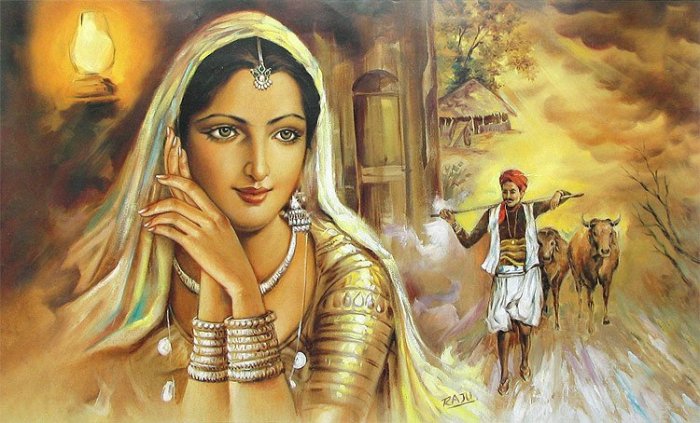When the term “Indian painting” is used, it usually conjures up images of lush green landscapes and swirling rakshasa demons. These are all common depictions of the style called “Varka” (pronounced var-KAH), but there’s much more to this tradition than meets the eye. Indian paintings have a rich history that predates European contact by thousands of years. Modern trends and western interpretations have their importance recognized, but when properly understood, these variegated traditions offer a wealth of insight into ancient practices, aesthetics, and values.
Here, painter Rajesh Saggi, whose style was influenced by ancient Indian painters, will give you an introduction to the Indian painting style.

What Is Indian Painting?
Indian painting, also known as Varka, refers to a large body of artistic traditions found throughout South Asia. It is a tradition that flourished in part due to the lack of historical knowledge of the early European colonialists who first encountered it. Rajesh Saggi shares that Indian paintings often feature vibrant, lively scenes with strong elements of fantasy and invention. The most famous of these are the works of the Mughal emperors, but other schools of painting also exist. The term “Indian painting” may be used in either of two ways: as a synonym for Mughal painting or as a general term to cover a number of different traditions. The first sense is closer to the original, but the second is more inclusive. For the purposes of this article, however, Rajesh Saggi will use the second definition since that is the one that has been widely accepted.
Theories on the origins of Indian painting
Theories on the origins of Indian painting have been debated for decades, with traditionalists arguing that ancient Indian art was based on indigenous traditions, and modernists claiming that Indian art borrows primarily from the west. In this article, Rajesh Saggi will examine the theories from both sides and attempt to unpack the complex motivations behind each theory.
The importance of traditional styles
Theories about the origins of Indian painting tend to beget theories about the importance of traditional styles. Traditional styles often feature vibrant and diverse popular imagery, with strong elements of fantasy and invention. The popular motifs of folk art are often seamlessly merged with religious, mythological, and/or historic themes. These elements are also present in the artworks of Rajesh Saggi, whose style was inspired by Indian painting.
Milieu, Style and Perception in Indian Painting
As mentioned above, the most important quality that differentiates traditional from western painting is the milieu, style and perception in which the two traditions evolved.
Traditionally, the term milieu refers to the cultural environment in which an art form flourishes. However, it can also be used to refer to the social, political and economic environment within which an art form exists. When used in this sense, the word “milieu” is synonymous with “modes of Being,” which can be used to refer to a style or a school of art.
Rajesh Saggi explains that the word “style” is also used in a manner that relates to the way that a culture’s art forms incorporate various elements from other art forms. For example, Dogra art, inspired by the Mughal art form, borrows heavily from other art forms, but nonetheless maintains its unique style.
Differences between traditional and western paintings
In addition to the importance of traditional styles, westerners’ perceptions of traditional painting can also affect how these works are viewed. Traditionally, the term “western” has been applied to works that feature primarily European and American subjects, while “traditional” has been used to describe works that feature primarily indigenous content.
However, Rajesh Saggi indicates that the current trend in western painting is to distance itself from the term “traditional,” and instead use it to refer to only the least modern forms of art.
Indian art is a diverse tradition spanning thousands of years. It has evolved both independently and in tandem with various foreign influences, including western art. As such, it can be difficult to distinguish between Indian and western paintings, especially when both traditions are represented by the same artist.
There are a number of important distinctions between western and traditional forms of Indian painting.
Rajesh Saggi, who has been researching these topics for a decade, has attempted to share them:
– Traditionally, a Varka painting features a large team of artists working together to create a single composition. The techniques used for creating the painting vary from traditional techniques used for sculpture and architecture, to oil painting and watercolor.
– Varkas are often vibrant and colorful, with a heavy emphasis on the depicted scene.
– Varkas are often characterized by intricate, multiple painting techniques, often featuring swirling patterns and vibrant hues.
– Varkas often feature animals such as elephants, lions, tigers, monkeys, etc. that are commonly depicted in art across the world.
– Varkas often use a number of different artistic styles to create their various elements, including the use of multiple media, the depiction of various historical periods, and the employment of fantasy.
Conclusion
While there are many similarities between Indian and Western painting, there are also distinct differences that separate the two. Most notably, the importance of the decorative arts and architecture in early Indian culture has been replaced in the post-medieval West by a more representational style. The western artistic tradition has had a major impact on Indian art, but it must be remembered that Indian traditions have gone on for millennia before being influenced by the west. Western tradition has been deeply influenced by western art, but at the same time, it has contributed to the traditions of Indian painting in significant ways.